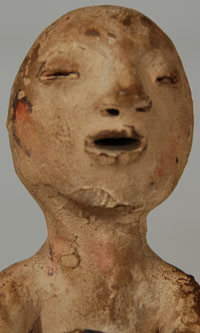Nineteenth Century Tesuque Rain God [SOLD]
+ Add to my watchlist Forward to Friend
- Category: Figurines
- Origin: Tesuque Pueblo, TET-SUGEH
- Medium: clay, paint
- Size: 5-1/2” tall
- Item # C3387 SOLD

The origin of Tesuque Rain Gods is still somewhat in question. They may be an indigenous development out of a more general Tewa tradition. Before the emergence of the figurine as we know it today, there existed figurines closely related to Kokopelli, the humpbacked, phallic flute player. These early figurines displayed sexual characteristics of male and female genders. A strong similarity exists between these ancestral Rain God figurines and the late 19th century ones. The sexual characteristics disappeared rapidly once the figurines became commercial products.
Their entry into the commercial realm was due to a Santa Fe merchant named Jake Gold who offered Tesuque potters ten cents for each figurine. The potters removed the sexual characteristics from the dolls (probably at the request of Gold) and placed a pot in the lap or on the head. Thus we have the Rain God, as we know it today.
This fine example of a Tesuque Rain God, which probably dates to circa 1890s, originally had paint on his cheeks but most of that is worn away. It appears that the figurine might have had a short beard on his chin but it is not clearly evident that this is so.
Condition: the right foot is partially broken off but not very evident because it is under the jar.
Provenance: from a young man in Albuquerque who inherited it from his grandfather who grew up on Tesuque Pueblo.
Recommended Reading: The Native American Curio Trade in New Mexico by Jonathan Batkin
- Category: Figurines
- Origin: Tesuque Pueblo, TET-SUGEH
- Medium: clay, paint
- Size: 5-1/2” tall
- Item # C3387 SOLD


